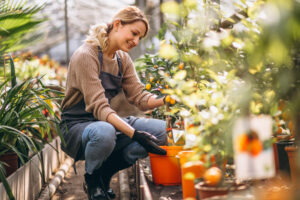 Choose the place where our plants will be planted: pot or garden.
Choose the place where our plants will be planted: pot or garden.
The choice of one or the other will determine the number of plants we can have and their size (herbaceous, vines, shrubs, trees). To plant and transplant in a pot, you must consider the plant species and its requirements related to the number of hours of sun, irrigation, and substrate. For example, some species are in full sun, and others will not. Furthermore, due to their characteristics, some species are not suitable for growing in a pot.
Select the pots and clean them.
There are different types of materials: plastic, ceramic, clay, etc. Most importantly, the size is appropriate and perforated at the base to allow proper drainage and prevent the roots from rotting. Some are already drilled, and others have to be drilled (if they are made of plastic, by slightly heating the tip of a knife, nail, or screwdriver, we can do it without problems).
Prepare the substrate for planting.
The substrate not only allows a correct anchoring of the plant, but it is also where the necessary nutrients are taken to develop healthily. Find the soil mixture that best suits what the plant needs. It is recommended that the substrate be composed of fertile soil, perlite, and vermiculite.
Transplant.
It consists of moving the plant from a smaller container to a pot that will be its definitive place. When doing this procedure, it is important that the plant suffers as little as possible. It is recommended to do it when there is no direct exposure to the sun. The steps are as follows: Add about 2 cm. of vermiculite or pebble at the pot’s base, remove the seedling from its container along with its soil, place it in the pot, and complete it with the substrate.
To plant on a patio or garden
In this type of space, we can opt for larger plants. The availability of sun, water, and substrate must be considered. If you buy the plant locally, ask the seller what conditions the plant needs to grow healthy. You can also find this information online by searching for the plant’s name. Some plants are in the autumn-winter season, and others are in the spring-summer season, but some adapt to temperature variations.
 Prepare the ground.
Prepare the ground.
Before planting or transplanting, it is recommended to prepare the soil: this activity consists of softening the soil a little with tools such as spades or shovels to aerate it, and, if possible, it is recommended to fertilize it, adding 3 kg. of compost per m2 of land.
Make a hole and insert the plant.
The size of the plant will be what defines the hole size that will have to be made. Remember that the plant must be buried up to the part where the roots join the stems. We suggest making a hole that measures more or less twice the size of the soil pan that comes with the plant. Place the plant in the hole and place a small layer of compost around it. Press with your hands and water. If you use seeds, remember that the seed must be deposited at a depth equivalent to 1½ of its diameter. Covering the soil with mulch is advisable to prevent soil erosion and retain moisture. It is made up of organic matter of plant origin, such as dry leaves and dry grass, although good results are also achieved with wood shavings (except pine or eucalyptus wood). This mulch will eventually be incorporated into the soil as a natural fertilizer.
What tools can you use to plant a plant?
- Transplanter: It will help you make the holes faster and easier. It has a plastic handle and a wide blade.
- Gardening shovel (can be wide or pointed): With this tool, you can move larger amounts of soil faster, making your task easier.
-
Other useful tools are the rake, the spade, and the pruning shears.
